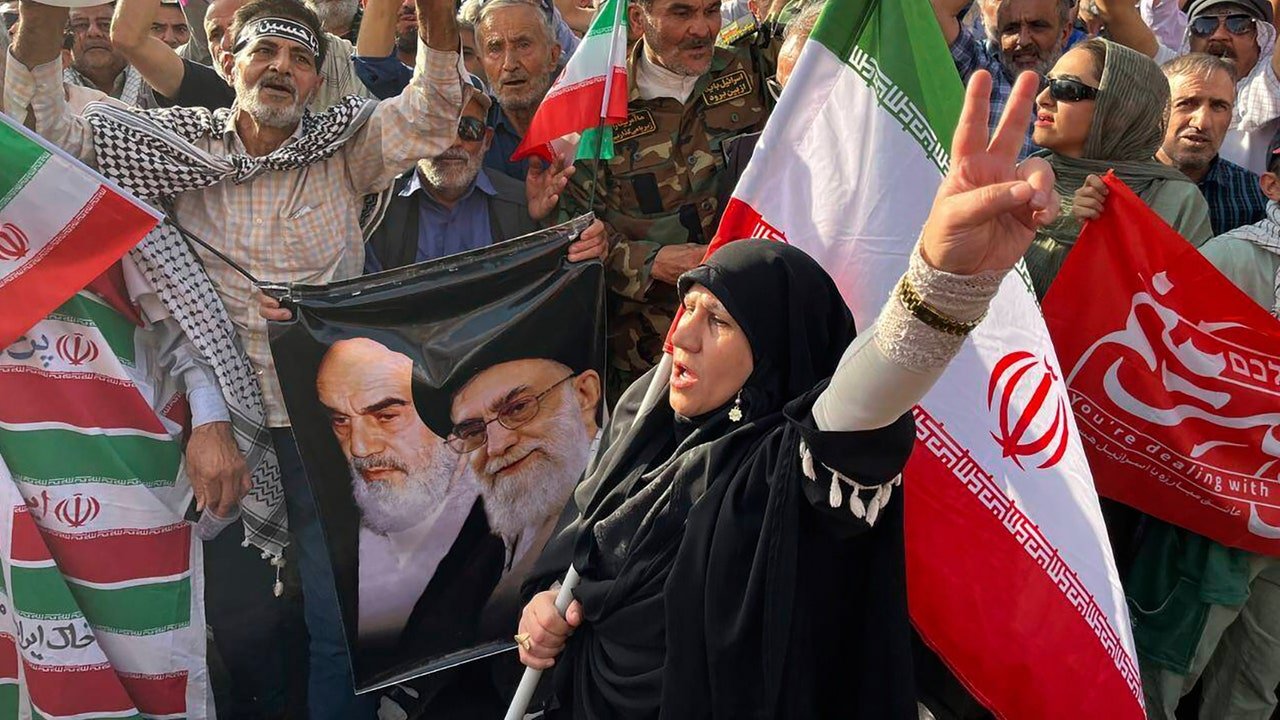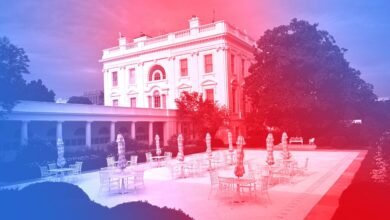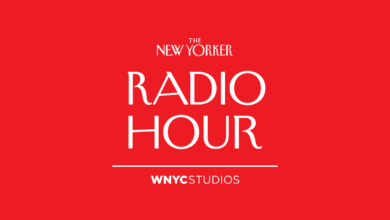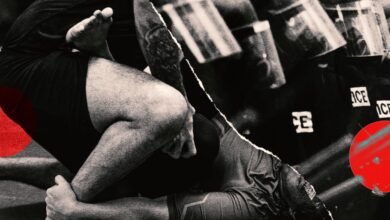
Just hours after the U.S. bombed three nuclear sites in Iran on Sunday, President Masoud Pezeshkian joined thousands of anti-American protesters in Tehran’s Enghelab Square. Enghelab means “revolution” in Farsi. The angry crowd waved placards vowing that they were “ready for the big battle” and calling for “revenge, revenge.” One poster depicted President Donald Trump as a snarling vampire. The Iranian regime has long been able to mobilize its base for propaganda purposes and social-media imagery. But, after ten days of barrages by the American and Israeli militaries, the more telling banners made plaintive and prideful statements. “Iran is our homeland,” one declared. “Its soil is our honor. And its flag is our shroud.”
The outcome of this war may be shaped more by Iran’s culture and politics than by the military prowess of its opponents. Iran’s controversial nuclear program is only part of a larger conundrum. Can the U.S. and Israel coexist with the Islamic Republic at all after forty-six years of fraught enmity? And will the Supreme Leader, Ayatollah Ali Khamenei, and the Islamic theocracy survive politically after the military onslaughts?
Following the unprecedented deployment of U.S. stealth aircraft and bunker-busting bombs, Trump called for an end to hostilities, and renewed negotiations with Tehran. “Iran, the bully of the Middle East, must now make peace,” he said, in a televised address. In a subsequent briefing at the Pentagon, his Defense Secretary, Pete Hegseth, told reporters that Operation Midnight Hammer, which lasted a mere twenty-five minutes, “has not been about regime change.” But, by Sunday afternoon, Trump posted, on Truth Social, “It’s not politically correct to use the term, ‘Regime Change,’ but if the current Iranian Regime is unable to MAKE IRAN GREAT AGAIN, why wouldn’t there be a Regime change??? MIGA!!!”
Israel has been even more explicit. Its Defense Minister, Israel Katz, said that Khamenei is a “modern Hitler” and “cannot continue to exist.” On Monday, Israel struck two of the biggest symbols of Iranian repression: the entryway of the infamous Evin Prison, where thousands of dissidents have been held, and the headquarters of the Basij, the paramilitary wing of the Revolutionary Guard, which is used to crack down on opposition. It also hit other internal security sites. In a statement, the Israeli Defense Forces said that the facilities have been responsible “for homeland defense, suppressing threats, and maintaining regime stability.”
Later on Monday, Iran launched its anticipated response to the U.S. strikes, with short- and medium-range missile barrages on Al Udeid Air Base, in Qatar, the largest American military installation in the region. The Supreme National Security Council, the chief decision-making body in Tehran, which includes political and military leaders, said in a statement that it had fired the same number of missiles that the U.S. used over the weekend. The response mirrors Iran’s retaliation, in 2020, after the U.S. killed General Qassem Suleimani, the leader of the Revolutionary Guard’s Quds Force. It fired missiles on U.S. forces at the Ain al-Asad base in Iraq. Hostilities de-escalated after that. This time, Tehran reportedly sent warning of its strike in advance. Several American warplanes and ships had already been moved last week.
I suspect that millions of Iranians would not miss Khamenei, an accidental leader who stepped into top jobs only after others died unexpectedly. He was a mid-level cleric when he became President, in 1981; a terror attack had killed his predecessor. Six years later, I had breakfast with him, in an ornate room at the Waldorf-Astoria, in New York. It was during his only trip to the West, when he spoke at the opening session of the U.N. General Assembly. In our meeting, he lacked charisma, worldliness, and intellectual depth. He mumbled his way through inflammatory rhetoric as a member of his Revolutionary Guard team bent over to cut up his breakfast meat. (He lost the use of his right arm in 1981, after a bomb hidden in a tape recorder went off as he spoke at a mosque in Tehran. His hand dangles at his side.) In 1989, he stepped in after the revolutionary leader, Ayatollah Ruhollah Khomeini, died suddenly, with no heir apparent. Khamenei had a limited independent political base, so he tapped into the Iranian military. They have empowered each other ever since.
The fate of the Islamic Republic is not necessarily dependent on the fate of its ruling Ayatollah. “Khamenei as a leader may not survive this war—either because he is literally taken out of the scene through an assassination or because the war ends with such a disastrous outcome for the country that he will be forced to step down,” Ellie Geranmayeh, a senior fellow at the European Council on Foreign Relations, told me. Khamenei now faces only bad options. He will, however, avoid unconditional surrender at all costs. He would “likely prefer being taken down as a martyr rather than going down in history as the Iranian leader who capitulated with a gun to his head,” Geranmayeh said.
The majority of Iranians are Shiite. The sect emerged in the seventh century, after the Prophet Muhammad died, during a political dispute over leadership with mainstream Sunnis. Shiism preaches that it is better to die fighting for justice than to live with injustice. Imam Hussein, an early Shiite leader, fought Sunnis in the Umayyad dynasty, even though he had only a few dozen fighters and knew they were grossly outnumbered and bound to die. Martyrdom remains central to devout Shia. I’ve travelled in Iran for decades, and I think it is among the most secular countries in the Middle East. Yet the history of the faith and its traditions still define the culture and the mind-sets of many. Iranians are also religious and ethnic minorities in the wider world, and that has bred existential fears of foreign conquest.
“Shiism is a culture of resistance,” Fatemeh Haghighatjoo, a former member of Iran’s parliament, told me. Elected in 2000 at the age of thirty-two, she was the youngest female lawmaker in the revolution’s history. She was barred from running a second time, in 2004, after accusing the regime of torturing political prisoners and manipulating elections. She left Tehran a year later and now lives in Massachusetts. Iranians “are basically against authoritarianism, and they don’t like what’s going on in the country,” she told me. But Haghighatjoo doesn’t see the regime abruptly collapsing. Khamenei could easily be replaced, she said. Article 111 of Iran’s constitution, which is modelled on French and Belgian law, calls for a troika—made up of the President, the judiciary chief, and a cleric from the Guardian Council—to assume the duties of the leader if he is incapacitated or dismissed. An eighty-eight-man Assembly of Experts, which is democratically elected every eight years, would then select a new one.
After almost half a century, the Islamic Republic has deeply entrenched institutions—and intense rivalries among its executive, legislative, judicial, military, and intelligence branches. But they all crave survival despite their bickering, John Limbert, one of fifty-two diplomats held hostage after the U.S. Embassy was seized, in 1979, told me. “They love power. They’ve kept it. They’ve kept other people out of it,” he said. “For better or worse, they’ve built a system that is resilient. There’s a cadre, a men’s club” that includes the first generation of revolutionaries or their acolytes. For most of the past twenty-five hundred years, Limbert noted, Iran has been led by dictators—“some bad, some terrible. Some with crowns, some with turbans, some with military uniforms.” And, if regime change does happen, he cautioned, “Why should we assume it’s for the better? People assumed that in 1979. ‘Let’s get rid of the shah and everything will be better.’ ”
Source link






